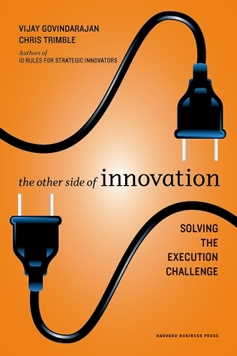 As the battle heats up in the advertising business and the friction between agencies, even those who are meant to be sister companies, grows even more severe the challenge laid out by Govindarajan and Trimble in their book The Other Side of Innovation: Solving the Execution Challenge becomes ever more obvious for our industry.
As the battle heats up in the advertising business and the friction between agencies, even those who are meant to be sister companies, grows even more severe the challenge laid out by Govindarajan and Trimble in their book The Other Side of Innovation: Solving the Execution Challenge becomes ever more obvious for our industry.
It’s not that ideas are easy to come by, of course many hours of good research, strategic analysis and creative ideation must go into the work to come up with the seed that will give a mobile app, a website or even a TV spot it’s super twist – but more often than not, once we have a strategy or an idea, the process of working through teams, agencies and clients can destroy it to such an extent that we are left with a mere shadow of what was initially envisioned.
As the vice chairman of Ford, Allan Gilmour, says in the Fast Company book The Rules of Business, “A half-baked strategy well executed will be superior to that marvelous strategy that isn’t executed very well,” and this is where the current challenge in the advertising business is really to be found.

When we look at the state of the market today, we see an enormous atomisation of experts, channel leaders, and strategists – between the media agencies, both offline and online who can sometimes coordinate and control the largest pot of dollars, to the ad agencies (who like to see themselves as the brand guardians, but at the end of the day seem to have very little stick to guardian with) and then the plethora of specialist agencies from social to mobile to shopper and web, and now beyond as we start to see niche markets open up for phygital (physical + digital) activation at events and the legacy of search agencies who believe that SEO and SEM can work in isolation.
What this gives us is a bunch of different strategists, working with different research and information, coming up with different insights and hence trying to lay out and execute different strategies – if we think back to Ries and Trout’s book The 22 Immutable Laws of Branding, we are clearly breaking number 5, the law of focus, if not several others as we try to drive a brand in multiple directions at the same time.
So what is the solution?
To come back to Govindarajan and Trimble, the key lies both in building the right team and also managing the process of execution – two features that need a strong leader who can manage all the moving parts and focus on getting the right execution out the door, as Cindy Gallop, Founder and CEO of IfWeRanTheWorld says, “the future of advertising is about making stuff.” Looking at the marketing ecosystem that we described above, this is most definitely not the case today in the majority of organizations. Many believe that this should be the role of the brand marketing team, the marketing director and brand manager – but then we must question why strategy is pushed out the door and given to agencies to handle.
If strategy must remain with the agency – and I firmly believe they are best placed to handle this, as they are one step removed from the politics and administration of working within the organization – then we need to put everything, and everybody in one place, rebuild the agency team and give the strategists a single direction and the real ability to execute.

This potentially means bringing the strategic thinkers, the channel and the creative back together, by creating teams that are not separated by brand names, networks and P&L accounts. I wrote a while ago about how marketing services should have acquired advertising, and how I admired those agencies that have managed to bring a portion of media back into the fold of the brand agency, but these examples are few and far between – the most interesting of these is probably OgilvyOne with the creation of the internal media unit Neo@Ogilvy, or many boutique agencies who still believe in the notion of ‘full-service’, but there are most definitely more along the same lines.
I have long been a fan of Jim Taylor’s book, Space Race: An Inside View of the Future of Communications Planning, where he lays out a new type of agency that brings together these different pieces to drive single-minded strategy and branding; but what worries me is that even though it was published in 2005, almost 6 years later the problem seems to be getting worse rather than better.
In a business driven by the bottom line, we need to find a way to give real strategy its place, and my concern that the agencies winning this battle are not the big network names, but more these small boutique shops that drive their own structures and agenda – the fact that they are winning business away from Madison avenue should be a warning sign that finally, 6 years after Taylor’s book, the future of communications planning is upon us.

